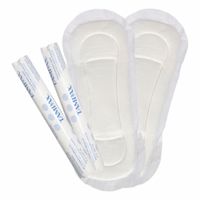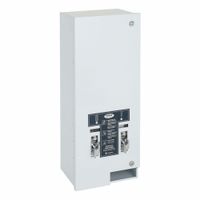Call +(254) 703 030 000 / 751 483 999 / 721 704 777
- Home
- Cleaning And Janitorial
- Hand Personal Care
- Sanitary Napkins Tampons Dispensers
.....Read More
Frequently Asked Questions
What are the benefits of using individually wrapped sanitary napkins and tampons in commercial restrooms?
Individually wrapped sanitary napkins and tampons in commercial restrooms offer several benefits:
1. **Hygiene and Safety**: Individual wrapping ensures that each product remains clean and free from contamination until use. This is crucial in maintaining personal hygiene and preventing infections.
2. **Convenience**: Users can easily carry wrapped products in their bags or pockets without worrying about exposure to dirt or damage. This convenience is particularly beneficial for unexpected menstrual needs.
3. **Privacy**: Individually wrapped products offer discretion, allowing users to carry them without drawing attention, which can be important in maintaining privacy in public settings.
4. **Reduced Waste and Spillage**: Wrapping helps prevent products from getting damaged or soiled, reducing waste. It also minimizes the risk of spillage or scattering, keeping restrooms cleaner.
5. **User Confidence**: Knowing that products are individually wrapped can increase user confidence in the quality and safety of the products provided, enhancing their overall restroom experience.
6. **Compliance and Standards**: Many health and safety regulations require or recommend individually wrapped sanitary products in public restrooms to ensure hygiene standards are met.
7. **Brand Image and Customer Satisfaction**: Providing high-quality, individually wrapped products can enhance a business's reputation, showing that it cares about the comfort and well-being of its customers or employees.
8. **Accessibility**: Individually wrapped products can be easily dispensed from vending machines or dispensers, ensuring they are readily available when needed.
9. **Allergen and Sensitivity Considerations**: Wrapping can help protect products from allergens or irritants in the environment, which is important for users with sensitivities.
Overall, individually wrapped sanitary products in commercial restrooms contribute to a cleaner, safer, and more user-friendly environment.
How do you restock sanitary napkin and tampon dispensers efficiently?
To efficiently restock sanitary napkin and tampon dispensers, follow these steps:
1. **Schedule Regular Checks**: Establish a routine schedule for checking dispensers, ideally during low-traffic times to minimize disruption. Frequency depends on usage patterns, but weekly checks are a good starting point.
2. **Monitor Usage Patterns**: Keep track of how quickly products are used to adjust restocking frequency. High-traffic areas may require more frequent restocking.
3. **Maintain Inventory**: Keep an adequate supply of sanitary napkins and tampons in storage. Use inventory management techniques like FIFO (First In, First Out) to ensure products are fresh.
4. **Standardize Products**: Use the same brand and type of products across all dispensers to simplify inventory management and ensure consistency for users.
5. **Train Staff**: Ensure that staff responsible for restocking are trained on the process, including how to open and secure dispensers, and the importance of hygiene.
6. **Use Checklists**: Implement checklists for staff to follow during restocking to ensure no steps are missed, including checking for damage or malfunction.
7. **Optimize Dispenser Placement**: Ensure dispensers are easily accessible and visible to users. Consider placing them near restrooms or in high-traffic areas.
8. **Feedback Mechanism**: Provide a way for users to report empty or malfunctioning dispensers, such as a contact number or a digital reporting system.
9. **Regular Maintenance**: Regularly inspect dispensers for wear and tear. Promptly repair or replace any that are damaged to ensure continuous availability.
10. **Evaluate and Adjust**: Periodically review the restocking process and make adjustments based on feedback and usage data to improve efficiency.
By following these steps, you can ensure that sanitary napkin and tampon dispensers are consistently stocked and functional, providing reliable service to users.
What are the best practices for maintaining sanitary napkin and tampon dispensers?
1. **Regular Inspection**: Conduct frequent checks to ensure dispensers are functioning properly and are stocked adequately. This helps in identifying any mechanical issues or shortages promptly.
2. **Scheduled Refilling**: Establish a routine schedule for refilling dispensers to prevent them from running out of supplies. This ensures availability and reliability for users.
3. **Cleaning Protocols**: Implement a strict cleaning regimen. Use appropriate disinfectants to clean the exterior and interior surfaces of the dispensers to prevent the spread of germs and maintain hygiene.
4. **Maintenance Checks**: Regularly inspect for wear and tear or any mechanical issues. Address any problems immediately to ensure the dispensers are always operational.
5. **User-Friendly Design**: Ensure dispensers are easy to use and accessible to all users, including those with disabilities. Clear instructions should be visible on the dispenser.
6. **Feedback Mechanism**: Provide a way for users to report issues or suggest improvements. This can be a contact number or a feedback form placed near the dispenser.
7. **Quality Products**: Stock dispensers with high-quality sanitary napkins and tampons to ensure user satisfaction and comfort.
8. **Secure Installation**: Ensure dispensers are securely mounted to prevent theft or vandalism. Regularly check the security of the installation.
9. **Training Staff**: Train maintenance staff on proper handling, refilling, and cleaning procedures to ensure consistency and quality in maintenance.
10. **Record Keeping**: Maintain logs of maintenance activities, including refilling and cleaning schedules, to track performance and identify areas for improvement.
11. **Emergency Supplies**: Keep a backup supply of products to quickly restock in case of unexpected demand or delays in regular supply.
How often should sanitary napkin and tampon dispensers be restocked?
Sanitary napkin and tampon dispensers should be restocked based on several factors to ensure consistent availability and hygiene. Generally, restocking should occur at least once a week, but this frequency can vary depending on the location, usage patterns, and the capacity of the dispensers.
In high-traffic areas such as schools, universities, airports, and large office buildings, daily or every other day restocking may be necessary to accommodate the higher demand. Monitoring usage patterns over time can help determine the optimal restocking schedule. For instance, if dispensers are frequently empty before the scheduled restocking, increasing the frequency is advisable.
In smaller or less frequented locations, such as small offices or community centers, weekly restocking might suffice. However, it is crucial to regularly check the dispensers to ensure they are not empty, as this can lead to inconvenience and discomfort for users.
Additionally, consider the capacity of the dispensers. Larger dispensers may require less frequent restocking, while smaller ones will need more regular attention. Implementing a tracking system or log can help maintain a consistent restocking schedule and ensure accountability.
It is also important to consider special events or seasonal variations that might increase foot traffic and demand, necessitating more frequent restocking during those times.
Ultimately, the goal is to maintain a reliable supply of sanitary products to promote hygiene and comfort for all users. Regular checks and adjustments to the restocking schedule based on actual usage data will help achieve this objective.
What types of sanitary napkin and tampon dispensers are available for commercial restrooms?
Sanitary napkin and tampon dispensers for commercial restrooms come in various types, catering to different needs and preferences. Here are the main types available:
1. **Manual Dispensers**: These require users to manually operate a lever or button to dispense a product. They are cost-effective and straightforward, making them a popular choice for many facilities.
2. **Automatic Dispensers**: Equipped with sensors, these dispensers automatically release a product when a hand is detected. They offer a touch-free experience, enhancing hygiene and user convenience.
3. **Coin-Operated Dispensers**: These require users to insert coins to access a product. They are often used in public restrooms to offset the cost of providing sanitary products.
4. **Free-Vend Dispensers**: These provide products at no cost to the user, promoting accessibility and convenience. They are increasingly popular in schools and workplaces aiming to support menstrual equity.
5. **Wall-Mounted Dispensers**: Designed to be affixed to restroom walls, these dispensers save space and are available in both manual and automatic versions.
6. **Recessed Dispensers**: Installed within the wall, these dispensers offer a sleek, space-saving solution that blends seamlessly with restroom decor.
7. **Dual Dispensers**: These units offer both sanitary napkins and tampons, providing users with a choice of products in a single dispenser.
8. **Compact Dispensers**: Ideal for smaller restrooms, these dispensers are designed to occupy minimal space while still providing essential products.
9. **High-Capacity Dispensers**: Suitable for high-traffic areas, these dispensers hold a larger quantity of products, reducing the frequency of refills.
10. **Customizable Dispensers**: Some manufacturers offer dispensers that can be customized with branding or specific color schemes to match restroom aesthetics.
These dispensers are typically made from durable materials like stainless steel or plastic, ensuring longevity and ease of maintenance.
How can businesses ensure access to feminine hygiene products in restrooms?
To ensure access to feminine hygiene products in restrooms, businesses can implement several strategies:
1. **Assessment and Planning**: Conduct a needs assessment to understand the demand for feminine hygiene products in restrooms. Consider factors such as the number of female employees, visitors, and the frequency of restroom use.
2. **Product Selection**: Choose a variety of products to cater to different preferences and needs, including pads, tampons, and panty liners. Opt for eco-friendly and hypoallergenic options to accommodate sensitive users.
3. **Strategic Placement**: Install dispensers in easily accessible locations within restrooms. Ensure they are visible and reachable, ideally near sinks or stalls, to maintain privacy and convenience.
4. **Free or Low-Cost Access**: Provide products for free or at a minimal cost. This can be achieved through sponsorships, partnerships with product manufacturers, or budget allocations. Free access can reduce stigma and ensure no one is left without essential products.
5. **Regular Stocking and Maintenance**: Establish a routine for checking and restocking dispensers to prevent shortages. Assign staff to monitor supplies and ensure dispensers are functional and clean.
6. **Awareness and Education**: Promote awareness about the availability of these products through signage in restrooms and internal communications. Educate employees about the importance of menstrual health and hygiene.
7. **Feedback Mechanism**: Implement a system for users to provide feedback on product availability and quality. Use this feedback to make necessary adjustments and improvements.
8. **Policy Integration**: Incorporate the provision of feminine hygiene products into the company’s health and wellness policies. This demonstrates a commitment to employee well-being and gender equality.
By adopting these measures, businesses can create a supportive environment that respects and addresses the menstrual health needs of all individuals.
What are the costs associated with providing sanitary napkins and tampons in commercial restrooms?
The costs associated with providing sanitary napkins and tampons in commercial restrooms can be categorized into several key areas:
1. **Product Costs**: This includes the direct cost of purchasing sanitary napkins and tampons. Prices vary based on brand, quality, and quantity purchased. Bulk purchasing can reduce per-unit costs.
2. **Dispensing Machines**: Installing and maintaining vending machines or dispensers involves initial capital expenditure. Costs depend on the type and technology of the dispenser, ranging from simple mechanical models to advanced electronic ones.
3. **Maintenance and Refill**: Regular maintenance of dispensers and timely refilling of products are necessary to ensure availability. This involves labor costs for staff responsible for these tasks.
4. **Storage and Inventory Management**: Adequate storage facilities are needed to keep a stock of products. Inventory management systems may be required to track usage and reorder supplies, incurring additional costs.
5. **Waste Management**: Providing disposal bins and managing waste generated from used products involves costs. This includes purchasing bins, liners, and hiring waste management services.
6. **Hygiene and Cleaning**: Ensuring cleanliness and hygiene in restrooms requires regular cleaning, which adds to labor and cleaning supply costs.
7. **Regulatory Compliance**: Adhering to local health and safety regulations may require specific investments, such as installing certain types of disposal units or dispensers.
8. **Marketing and Communication**: Informing users about the availability of these products may involve signage and communication materials, adding to the overall cost.
9. **Miscellaneous Costs**: These can include theft or vandalism of products and dispensers, requiring replacements or repairs.
Overall, while the initial setup costs can be significant, ongoing expenses are primarily related to product replenishment and maintenance.

